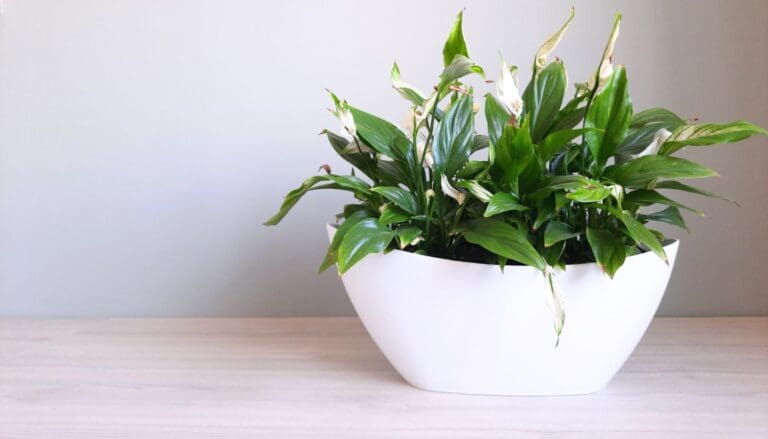Can Boston Fern Survive Winter Indoors? (+Winter Care & Dormancy)
Boston fern, often known as sword fern, is a plant loved for its evergreen foliage. Since Boston fern is a tropical plant, you might be thinking if it would survive winter indoors. Let’s find out.
Boston fern will generally survive the harsh winter indoors as long as it gets the right care and stays protected from low temperatures and frost. Keep your Boston fern safe and alive by overwintering, which is nothing but keeping them warm in a covered location.
You can bring your Boston fern inside your home and grow it as an indoor plant. Sometimes it’s also a good idea to let your fern undergo a period of dormancy and be overwintered in a cold, dark location such as a garage or basement.
This article will tell you how you can keep Boston ferns healthy and make them survive the harsh winter by keeping them indoors.

Please note: Simplify Plants is reader-supported. Some links in the post are affiliate links and I get a commission from purchases made through links in the post.
Do Boston ferns die in winter?
No, Boston ferns do not die in winter if properly cared for.
When the temperature is cold and harsh, they require some specific changes in the care, and they can survive easily through winter.
Finding the correct location for overwintering Boston ferns is the first step in helping them survive.
The plant requires low night-time temperatures and bright enough indirect light, such as that provided by a south window that is not obscured by trees or buildings.
Temperatures should not exceed 75°F during the day.
The Boston fern requires high humidity to stay healthy.
In a hot, dry home setting, overwintering Boston ferns usually result in mess and irritation for the gardener.
Allow Boston ferns to go dormant and keep them in a garage, cellar, or a building where temperatures don’t fall below 55°F if you don’t have the correct circumstances indoors.
Do Boston ferns go dormant?

Although Boston fern does not become dormant in the winter, hydration and humidity issues can cause its fronds to turn dry and brown, giving the impression that the plant has gone dormant.
You can restore the plant to health by correcting the issues, but the plant will lose the affected fronds.
But if the conditions are too adverse and it’s a lot of work to keep your fern in its healthy state, you can overwinter them.
Overwintering is nothing but letting the plant enter a state of slow dormancy so you can preserve its health during winter.
Care for Boston ferns in dormancy does not require providing light.
You can keep the plant in the dark spot while it sleeps.
The plant should still need to be watered thoroughly, although the dormant Boston fern only requires a small amount of moisture every month.
How cold is too cold for Boston fern?
The Boston Fernwhich grows hardy in Zones 10–12, prefers temperatures of 65-75°F (18-24°C).
Temperatures of 75°F during the day and 65°F at night are excellent for the Boston Fern.
Boston Ferns in pots have less soil insulation and protection than Boston Ferns in the ground, making them more susceptible to cold damage.
At temperatures below 45°F, potted Boston Ferns must be brought indoors, although planted Boston Ferns only require protection at temps below 30°F (-1°C).
Even if the temperature swings are within the acceptable range for Boston Ferns, i.e., 30° to 95°F (-1° to 35°C), Boston Ferns will not thrive in places with extreme temperature fluctuations.
Also read: Boston Fern Temperature Tolerance: +Ideal Temperature
Can Boston ferns survive winter?

Yes, Boston fern can survive winter.
You need to take care and provide your fern with the best possible care.
Different seasons require a different type of care for Boston fern, and winter care will be a lot different from summer care.
Please follow the below steps to understand the changes required in winter care for Boston fern.
Keep it indoors
The placement of your Boston fern is very important.
You should keep it somewhere you can see it every day so you can monitor or continue to view your plant.
That is something fern lovers would agree on.
The ideal place for your Boston fern to overwinter is:
- Without any drafts
- There is little light
- Away from animals
- Away from children
- Avoid contact with walls or other items
- The temperature should be between 50 and 60°F.
During the winter, Boston ferns do not require a lot of light.
If you store it near a window, make sure it’s filtered, or it will burn the leaves.
Keep them away from windows that face south or any other light source.
For them, the ambient light is sufficient.
Your home’s artificial lighting should suffice.
However, keep an eye out for signs of stress.
If it’s been particularly gloomy recently, you may need to supplement with some artificial light.
Watering

Boston ferns require very little watering in the winter.
Only water it when the top 1″ of soil is completely dry.
Don’t overwater your Boston fern.
This attracts pests, mildew, and fungus.
During the winter, keep your plants’ soil slightly damp.
You shouldn’t water it as much as you would during the growing season, but the soil should never be completely dry.
A thorough monthly watering should suffice, but double-check to be sure.
Use a moisture meter to confirm that the soil is ready for watering.
Also read: How To Water Boston Fern? (How Often, How Much & More)
Fertilizer

During the winter, no fertilizer or plant food is required.
Remember that it isn’t growing, so there’s no need to feed it.
Otherwise, you’ll end up bringing various issues into your Boston.
It’s virtually dormant and won’t require any feeding until the spring when it’ll be ready to provide you with those valuable greens once more.
Also read: Should I Fertilize My Boston Fern? (Ideal Fertilizer+When & How Much)
Pruning
Your Boston fern will not look as attractive in the winter.
It’ll be brown, yellow, drooping, or just miserable.
It’s fine if it wilts.
After all, it doesn’t get the same amount of sunlight or plant food as this one did.
It won’t be able to produce as lovely greens as it can in the summer without these essential components.
Remove the unsightly leaves.
It also deters bugs from trying to eat them, which is especially useful if you’re storing them inside your home.
You don’t want your kitchen to be infested with pests!
Also read: Should I Trim My Boston Fern? (+How To Prune)
Pests and diseases

Boston ferns can grow to be quite huge.
It’s fairly uncommon for chunks of it to go unnoticed for extended periods.
Check your plant for bugs at least once a week to avoid harm.
During the winter, inspect your Boston fern for spiders or mites and keep an eye out for them.
When the rest of your house is dry in the winter, bugs look for a damp environment to create a home in.
Many different varieties of fungi thrive in the warm, damp conditions that your Boston fern appreciates.
One way to avoid fungus on your Boston fern is to keep the temperature lower at night.
- To get rid of pests, spray the Boston fern foliage with a strong, but not damaging, stream of water. Examine the Boston fern for residual pests like snails, scales, or mites.
- Rinse or pick out pests or cut off parts of the Boston fern infested with the insects, which appear as little bumps on the surface of the fern.
- Soak the fern container in a tub of lukewarm water for 15 minutes, keeping the soil and growing container submerged. This will assist in driving away any pests that have taken up residence in the soil.
- Keep the Boston fern apart from other houseplants to avoid accidentally spreading pests.
- Use a Neem oil solution and spray it all over the plant till all the pests are eliminated.
- Use a fungicide if your Boston fern shows signs of fungal diseases.
Also read: Boston Fern Pests And Diseases: Common Bugs & Diseases+How To Fix
How to bring the Boston Fern indoors in winter?
- If the fern receives significantly more light outdoors, before bringing it indoors, gradually reduce the amount of light it receives over several weeks to allow for gradual adaptation and minimize shock and leaf loss.
- Place the Boston fern indoors in a location that receives about 2 hours of indirect sunlight each day during the winter and stays between 65 and 75°F during the day and approximately 10°F cooler at night.
- Mist the Boston fern with room-temperature water regularly, or place it in an environment with high relative humidity, such as a bathroom with a shower.
- If the relative humidity is too low, the frond tips of Boston ferns will turn brown or die, and the fern’s leaves will fall off. When the top inch of soil feels dry, water it.
- Inspect the fern for pests regularly or whenever you water or mist it. As soon as you find pests, cut off infested parts of the Boston fern or take other steps to handle them.
Final thoughts
It is quite easy to keep your Boston fern healthy and help it survive winters indoors. You just need to tweak the care routine for Boston ferns during winter.
This table will summarize all the necessary conditions that you will need to follow during the winter so that your fern survives the winter season.
| Factor | Winter Care Tips |
|---|---|
| Light | Boston fern cannot stand direct sunlight. In winter as well, keep it in the shade so that it can get enough indirect light for at least 2 hours per day. |
| Water | |
| Fertilizer | Do not add fertilizer during the winter. |
| Temperature | Keep the Boston fern near the kitchen or bathroom where it can be a moderately humid and cooler temperature. Make sure to keep the Boston fern away from heaters. Do not keep the fern outside as it will expose it to harsh cold temperatures. |
| Humidity | Boston ferns love humidity. Use a misting bottle to add moisture frequently. The soil should never become too dry, making the leaves dry and discolored. |
| Pest infestation | Cut off most of the foliage and clean the fern well before moving it indoors to avoid pest infestation. Use soap water and Neem oil as pest control spray. |
| Repotting | Repotting the fern makes it go through a lot of shocks. Avoid repotting it in harsh cold months if it’s not urgent, as it will only harm it more. |
Recommended Garden Supplies
| Product Image | Our Recommended Gardening Supplies | Check Offers! |
|---|---|---|
Top Top
Top
Top
Top
Top
Top
Top
Top | rePotme Houseplant and Tropical Classic Potting Soil Mix | Check Offer On Amazon |
 Top
Top
Top
Top
Top
Top
Top
Top | Espoma Organic Indoor Plant Food | Check Offer On Amazon |
 Top
Top
Top
Top
Top
Top
Top
Top | GooingTop LED Grow Light 6000K Full Spectrum Clip Plant Growing Lamp | Check Offer On Amazon |
 Top
Top
Top
Top
Top
Top
Top
Top | Soil Moisture Meter | Check Offer On Amazon |
 Top
Top
Top
Top
Top
Top
Top
Top | Govee Hygrometer Thermometer, Bluetooth Enabled! | Check Offer On Amazon |
 Top
Top | LEVOIT Humidifiers for Large Room(Best For Plants) | Check Offer On Amazon |
 Top
Top
Top
Top
Top
Top
Top
Top | Upgraded DIY Automatic Drip Irrigation Kit, 15 Potted Houseplants Support | Check Offer On Amazon |
 Top
Top
Top
Top
Top
Top
Top
Top | Stainless Steel Heavy Duty Gardening Tool Set | Check Offer On Amazon |
 Top
Top
Top
Top
Top
Top
Top
Top | Bonide Insecticidal Soap | Check Offer On Amazon |
 Top
Top
Top
Top
Top
Top
Top
Top | Bonide 32 oz Spray Neem Oil for Organic Gardening | Check Offer On Amazon |
 Top
Top
Top
Top
Top
Top
Top
Top | Garden Safe Fungicide | Check Offer On Amazon |






